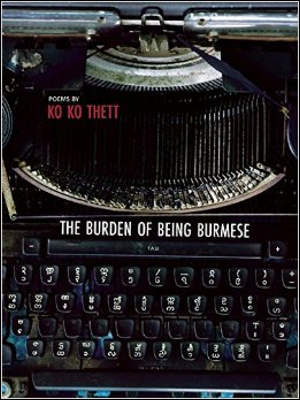|
by William B. Noseworthy

Ko Ko Thett, The Burden of Being Burmese, Zephyr Press and MCCM Creations, 2015. 112 pgs. The Burden of Being Burmese is an exciting first collection of poetry, and not only because it is the first full-length volume by any Burmese poet to be published in English. It also provides a valuable reflection of the new directions that Burmese poets have been taking in recent years. Traditionally, Burmese poetry was largely defined by formal literary structures—such as rhyming stanzas of four lines and nature imagery—and was often imbued with Buddhist lessons. This started to change when Khit San poetry, Burma's first modernist literary movement, emerged in the early twentieth century. Khit San works were generally composed of four rhyming lines of four syllables, frequently rounded off by lines of seven syllables. Nature imagery remained common in Khit San, although "every day" language was also gradually introduced into their works. The Khit San movement was then fo>'llowed by the Marxist influenced "New Writing," which emerged strongly after independence in 1948 and the military takeover in 1962.[i] By contrast, the content and form of Ko Ko Thett's new collection is perhaps more reminiscent of the Beats and the "open mouth" generation of Vietnamese and Vietnamese-American poets than these earlier Burmese traditions. His work comes on the heels of a recent flourishing in Vietnamese-American literature, and at times closely parallels the style and form of the translator, anthologist and author Linh Dinh. Seeing Ko Ko Thett's work in a regional and global context should not downplay the specificity of his approach, however. He explicitly presents himself as a critical national poet in exile, having published two Burmese-language chapbooks in 1996 without the approval of the censorship board. He was then jailed for his involvement in the student uprising of December 1996. Released in April 1997, Thett undertook an international literary career. His break out work appeared in a special series of translations in World Literature Today in 2012, for which he translated works from Khin Aung Aye, Tin Moe (d. 2007), Ma Ei, Maung Chaw Nwe (d. 2002) and Moe Zaw. The work of another widely celebrated Burmese poet, Zeyar Lynn, has clearly influenced this collection, and the poem "Monosodium glutamate" is even dedicated to him. However, Thett has not only been influenced by Burmese and Vietnamese literary figures but also by writers as disparate as Amy Tan, Jean-Paul Sartre, Benedict Anderson, Bob Dylan and William Blake. The poem "I've seen death," for example, includes a reference to Blake's famous line "death is just another room," although it is a reference that finds itself alongside very contemporary and global images such as the "new patois" of being international and the fear of "drones overhead." Despite the shared references that make Ko Ko Thett a distinctly international author, he has not entirely lost the influence of classical pyo Buddhist Burmese poetry, which was written in the Pali language and represented the peak of Burmese poetic form leading into the twentieth century. For example, the author includes references to the "the Buddha, dharma, sangha"; the reality that "life is simply dukkha" (the first noble truth in Buddhism) and "vipassana" (Theravada meditation) "for the masses." Elsewhere, however, he seems to turn away from Buddhist thought when he argues that "there is no such thing as metta, disinterested love." The experience of the poet therefore appears to be one of disenchantment, although he still seems to readily identify with Buddhist cosmology as a piece of "the burden." The Burden of Being Burmese demonstrates a distinct desire to teach an international audience about Burmese culture, history and life. It includes references, not only to Buddhism, but also to British colonialism, to the rule of the junta and to the rebellions of the literary scene. The book's appendix handily includes explanations of the Burmese terms that are sprinkled throughout the text. Hence, this new collection will be of interest to readers of poetry and those interested in history and politics, as well as to students and teachers seeking to learn more about historical and contemporary literary trends.
[i] See Byrne, James. 2012. "Burmese Poetry: Tectonic Shifts." World Literature Today. 86(1): 35-41; Dundes, Alan & Maung Than Sein. 1964. "Twenty-Three Riddles from Central Burma." Journal of American Folklore. 77 (3): 69–75 and Dunn, C.W, Hla Pe & J.A Stewart. 1948. "Country Life in Burmese Literature" Bulletin of the School of Oriental and African Studies, University of London. 12(3/4): 703-712. |